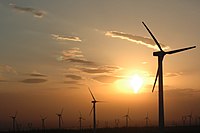Main article: Environmental issues in China
See also: Water resources of China
However, China is the world's leading investor in renewable energy commercialization, with $52 billion invested in 2011 alone;[164][165][166] it is a major manufacturer of renewable energy technologies and invests heavily in local-scale renewable energy projects.[167][168] By 2009, over 17% of China's energy was derived from renewable sources – most notably hydroelectric power plants, of which China has a total installed capacity of 197 GW.[169] In 2011, the Chinese government announced plans to invest four trillion yuan (US$619 billion) in water infrastructure and desalination projects over a ten-year period, and to complete construction of a flood prevention and anti-drought system by 2020.[162][170] In 2013, China began a five-year, US$277 billion effort to reduce air pollution, particularly in the north of the country.[171]

No comments:
Post a Comment